warning light FIAT DOBLO COMBI 2012 Owner handbook (in English)
[x] Cancel search | Manufacturer: FIAT, Model Year: 2012, Model line: DOBLO COMBI, Model: FIAT DOBLO COMBI 2012Pages: 283, PDF Size: 6.31 MB
Page 156 of 283
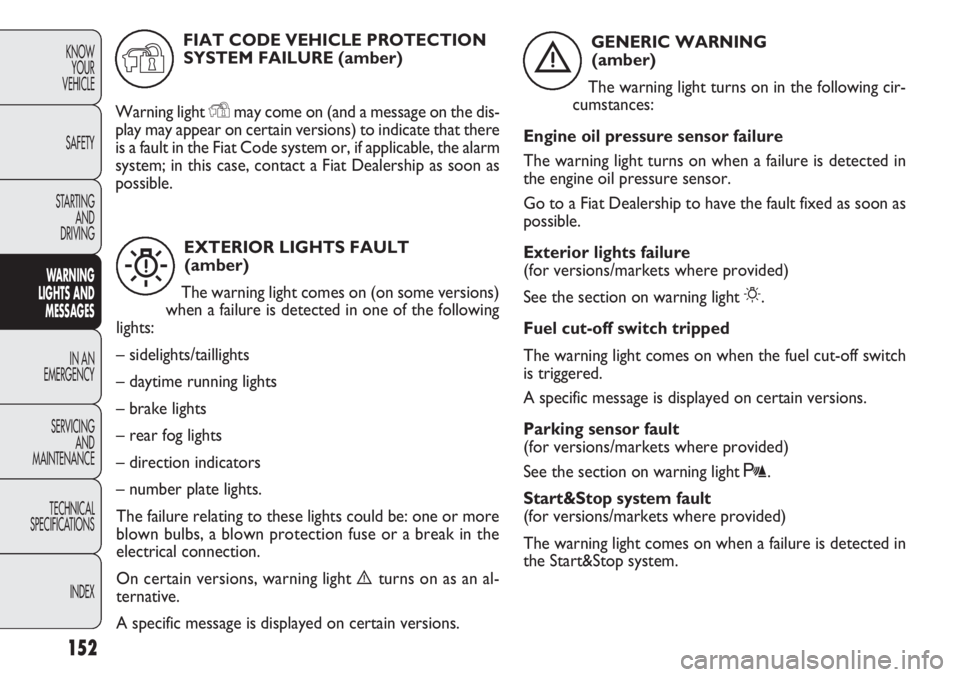
152
KNOWYOUR
VEHICLE
SAFETY
STARTING AND
DRIVING
WARNING
LIGHTS AND MESSAGES
IN AN
EMERGENCY
SERVICING AND
MAINTENANCE
TECHNICAL
SPECIFICA TIONS
INDEX
EXTERIOR LIGHTS FAULT(amber)
The warning light comes on (on some versions)
when a failure is detected in one of the following
lights:
– sidelights/taillights
– daytime running lights
– brake lights
– rear fog lights
– direction indicators
– number plate lights.
The failure relating to these lights could be: one or more
blown bulbs, a blown protection fuse or a break in the
electrical connection.
On certain versions, warning light è turns on as an al-
ternative.
A specific message is displayed on certain versions.
W
GENERIC WARNING (amber)
The warning light turns on in the following cir-
cumstances:
Engine oil pressure sensor failure
The warning light turns on when a failure is detected in
the engine oil pressure sensor.
Go to a Fiat Dealership to have the fault fixed as soon as
possible.
Exterior lights failure
(for versions/markets where provided)
See the section on warning light
6.
Fuel cut-off switch tripped
The warning light comes on when the fuel cut-off switch
is triggered.
A specific message is displayed on certain versions.
Parking sensor fault
(for versions/markets where provided)
See the section on warning light t.
Start&Stop system fault
(for versions/markets where provided)
The warning light comes on when a failure is detected in
the Start&Stop system.
è
FIAT CODE VEHICLE PROTECTION SYSTEM FAILURE (amber)
Warning light
Ymay come on (and a message on the dis-
play may appear on certain versions) to indicate that there
is a fault in the Fiat Code system or, if applicable, the alarm
system; in this case, contact a Fiat Dealership as soon as
possible.
Y
Page 157 of 283
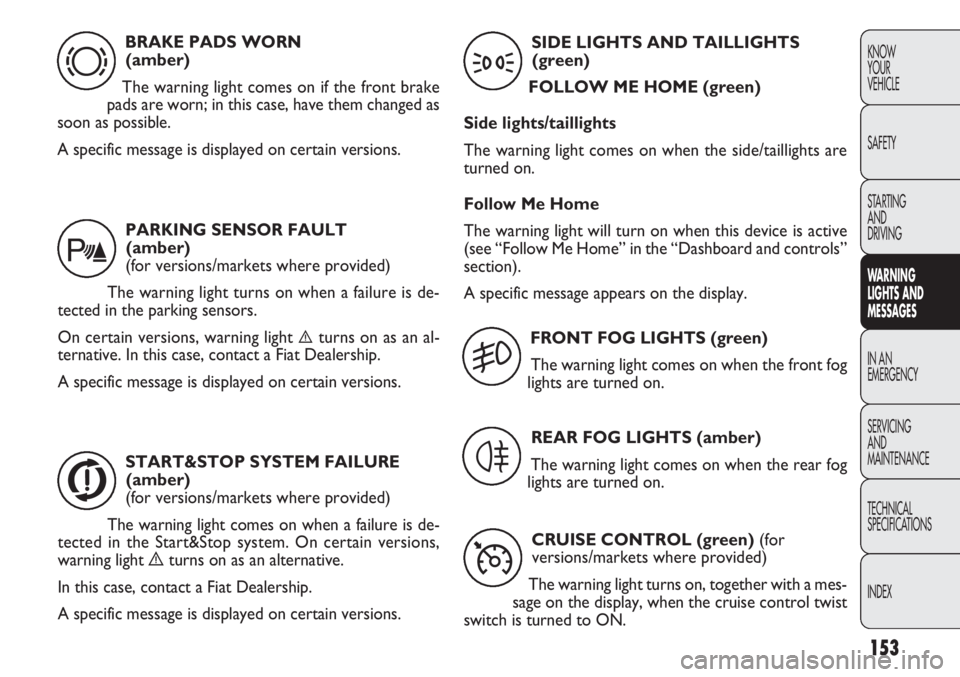
153
KNOW
YOUR
VEHICLE
SAFETY
STARTING
AND
DRIVING
WA R N I NG
LIGHTS AND
MESSAGES
IN AN
EMERGENCY
SERVICING
AND
MAINTENANCE
TECHNICAL
SPECIFICA TIONS
INDEXBRAKE PADS WORN (amber)
The warning light comes on if the front brake
pads are worn; in this case, have them changed as
soon as possible.
A specific message is displayed on certain versions.
d
PARKING SENSOR FAULT (amber)
(for versions/markets where provided)
The warning light turns on when a failure is de-
tected in the parking sensors.
On certain versions, warning light
èturns on as an al-
ternative. In this case, contact a Fiat Dealership.
A specific message is displayed on certain versions.
t
START&STOP SYSTEM FAILURE (amber)
(for versions/markets where provided)
The warning light comes on when a failure is de-
tected in the Start&Stop system. On certain versions,
warning light èturns on as an alternative.
In this case, contact a Fiat Dealership.
A specific message is displayed on certain versions.
j
SIDE LIGHTS AND TAILLIGHTS (green)
FOLLOW ME HOME (green)
Side lights/taillights
The warning light comes on when the side/taillights are
turned on.
Follow Me Home
The warning light will turn on when this device is active
(see “Follow Me Home” in the “Dashboard and controls”
section).
A specific message appears on the display.
3
FRONT FOG LIGHTS (green) The warning light comes on when the front fog
lights are turned on.
5
REAR FOG LIGHTS (amber)
The warning light comes on when the rear fog
lights are turned on.
4
CRUISE CONTROL (green) (for versions/markets where provided)
The warning light turns on, together with a mes-
sage on the display, when the cruise control twist
switch is turned to ON.
Ü
Page 158 of 283
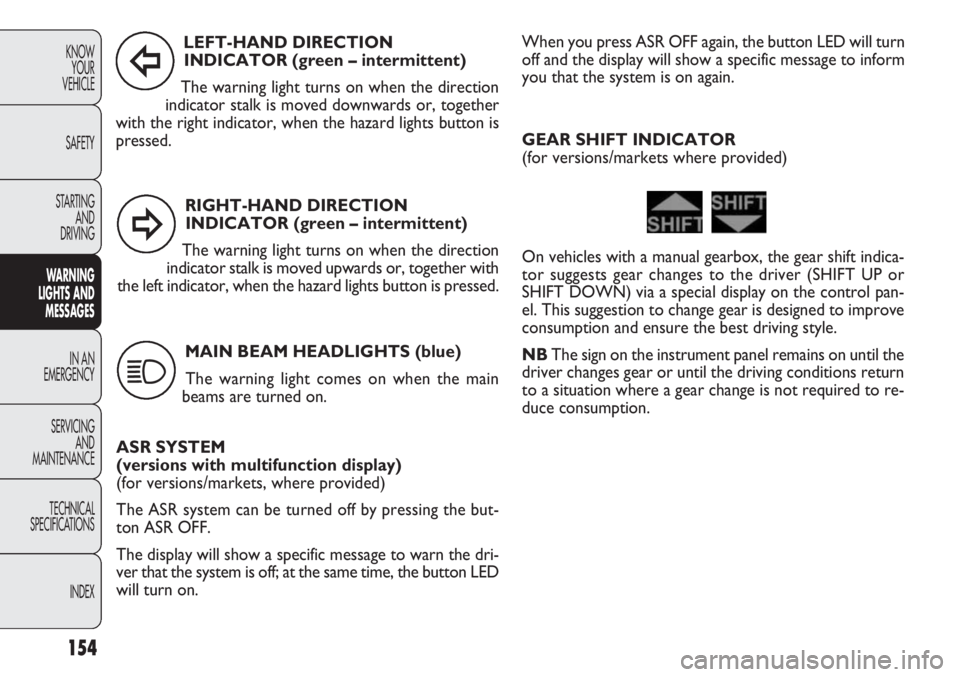
RIGHT-HAND DIRECTION INDICATOR (green – intermittent)
The warning light turns on when the direction
indicator stalk is moved upwards or, together with
the left indicator, when the hazard lights button is pressed.
154
KNOW YOUR
VEHICLE
SAFETY
STARTING AND
DRIVING
WARNING
LIGHTS AND MESSAGES
IN AN
EMERGENCY
SERVICING AND
MAINTENANCE
TECHNICAL
SPECIFICA TIONS
INDEXLEFT-HAND DIRECTIONINDICATOR (green – intermittent)
The warning light turns on when the direction
indicator stalk is moved downwards or, together
with the right indicator, when the hazard lights button is
pressed.
MAIN BEAM HEADLIGHTS (blue)The warning light comes on when the main
beams are turned on.
ASR SYSTEM
(versions with multifunction display)
(for versions/markets, where provided)
The ASR system can be turned off by pressing the but-
ton ASR OFF.
The display will show a specific message to warn the dri-
ver that the system is off; at the same time, the button LED
will turn on.
Î
¥
1
When you press ASR OFF again, the button LED will turn
off and the display will show a specific message to inform
you that the system is on again.
GEAR SHIFT INDICATOR
(for versions/markets where provided)
On vehicles with a manual gearbox, the gear shift indica-
tor suggests gear changes to the driver (SHIFT UP or
SHIFT DOWN) via a special display on the control pan-
el. This suggestion to change gear is designed to improve
consumption and ensure the best driving style.
NB The sign on the instrument panel remains on until the
driver changes gear or until the driving conditions return
to a situation where a gear change is not required to re-
duce consumption.
Page 159 of 283
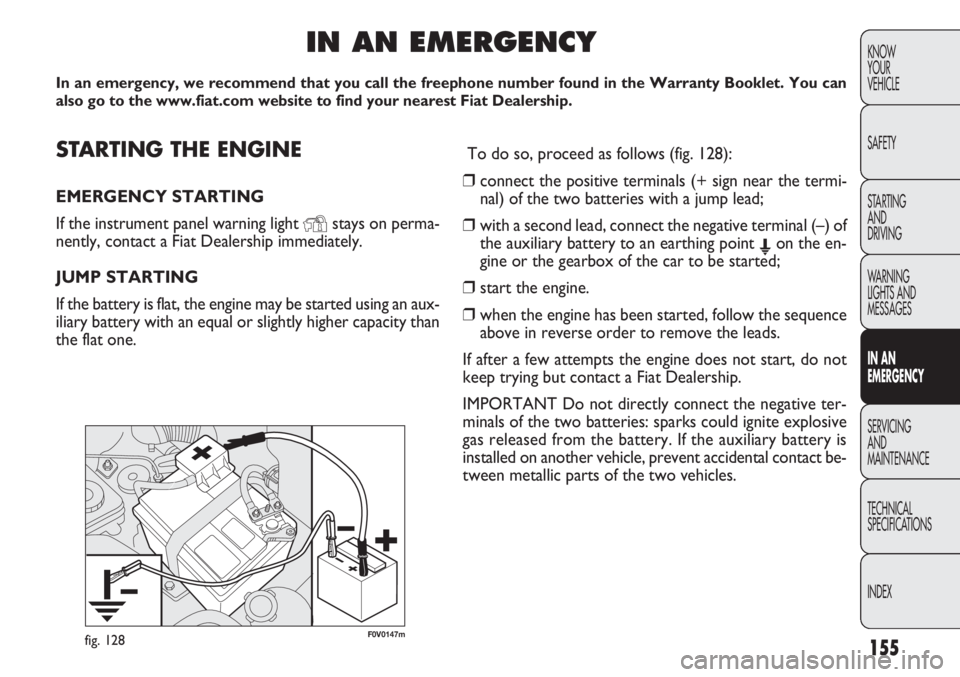
155
KNOW
YOUR
VEHICLE
SAFETY
STARTING
AND
DRIVING
WARNING
LIGHTS AND
MESSAGES
IN AN
EMERGENCY
SERVICING
AND
MAINTENANCE
TECHNICAL
SPECIFICATIONS
INDEX
F0V0147mfig. 128
STARTING THE ENGINE
EMERGENCY STARTING
If the instrument panel warning light
Ystays on perma-
nently, contact a Fiat Dealership immediately.
JUMP STARTING
If the battery is flat, the engine may be started using an aux-
iliary battery with an equal or slightly higher capacity than
the flat one.
IN AN EMERGENCY
In an emergency, we recommend that you call the freephone number found i\
n the Warranty Booklet. You can
also go to the www.fiat.com website to find your nearest Fiat Dealership\
.
To do so, proceed as follows (fig. 128):
❒ connect the positive terminals (+ sign near the termi-
nal) of the two batteries with a jump lead;
❒ with a second lead, connect the negative terminal (–) of
the auxiliary battery to an earthing point E on the en-
gine or the gearbox of the car to be started;
❒ start the engine.
❒ when the engine has been started, follow the sequence
above in reverse order to remove the leads.
If after a few attempts the engine does not start, do not
keep trying but contact a Fiat Dealership.
IMPORTANT Do not directly connect the negative ter-
minals of the two batteries: sparks could ignite explosive
gas released from the battery. If the auxiliary battery is
installed on another vehicle, prevent accidental contact be-
tween metallic parts of the two vehicles.
Page 160 of 283
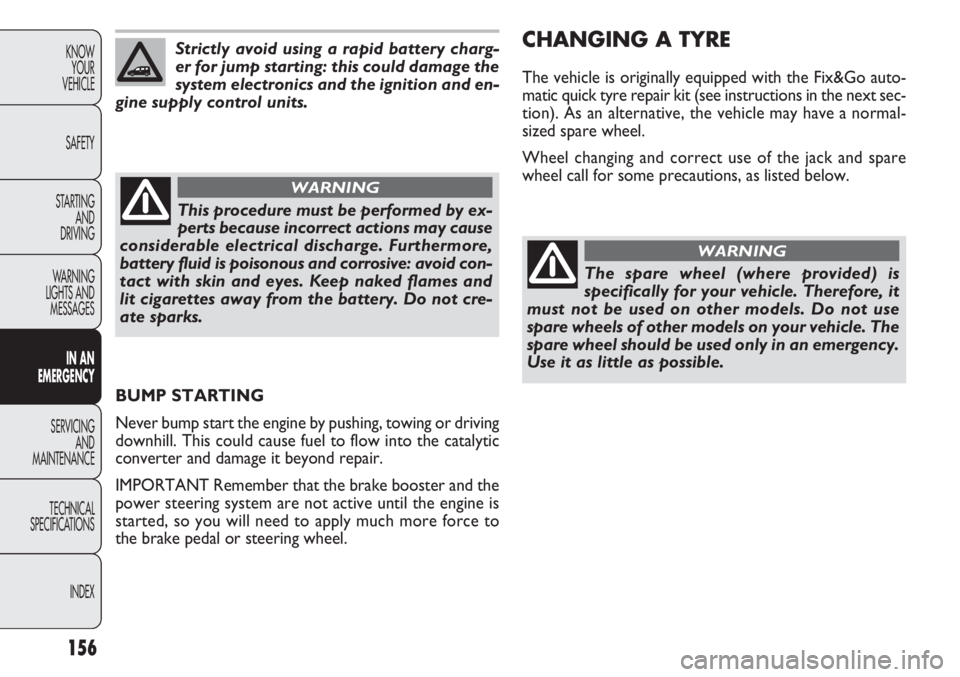
156
KNOWYOUR
VEHICLE
SAFETY
STARTING AND
DRIVING
WARNING
LIGHTS AND MESSAGES
IN AN
EMERGENCY
SERVICING AND
MAINTENANCE
TECHNICAL
SPECIFICA TIONS
INDEXStrictly avoid using a rapid battery charg-
er for jump starting: this could damage the
system electronics and the ignition and en-
gine supply control units.
This procedure must be performed by ex-
perts because incorrect actions may cause
considerable electrical discharge. Furthermore,
battery fluid is poisonous and corrosive: avoid con-
tact with skin and eyes. Keep naked flames and
lit cigarettes away from the battery. Do not cre-
ate sparks.
WARNING
BUMP STARTING
Never bump start the engine by pushing, towing or driving
downhill. This could cause fuel to flow into the catalytic
converter and damage it beyond repair.
IMPORTANT Remember that the brake booster and the
power steering system are not active until the engine is
started, so you will need to apply much more force to
the brake pedal or steering wheel.
CHANGING A TYRE
The vehicle is originally equipped with the Fix&Go auto-
matic quick tyre repair kit (see instructions in the next sec-
tion). As an alternative, the vehicle may have a normal-
sized spare wheel.
Wheel changing and correct use of the jack and spare
wheel call for some precautions, as listed below.
The spare wheel (where provided) is
specifically for your vehicle. Therefore, it
must not be used on other models. Do not use
spare wheels of other models on your vehicle. The
spare wheel should be used only in an emergency.
Use it as little as possible.
WARNING
Page 161 of 283
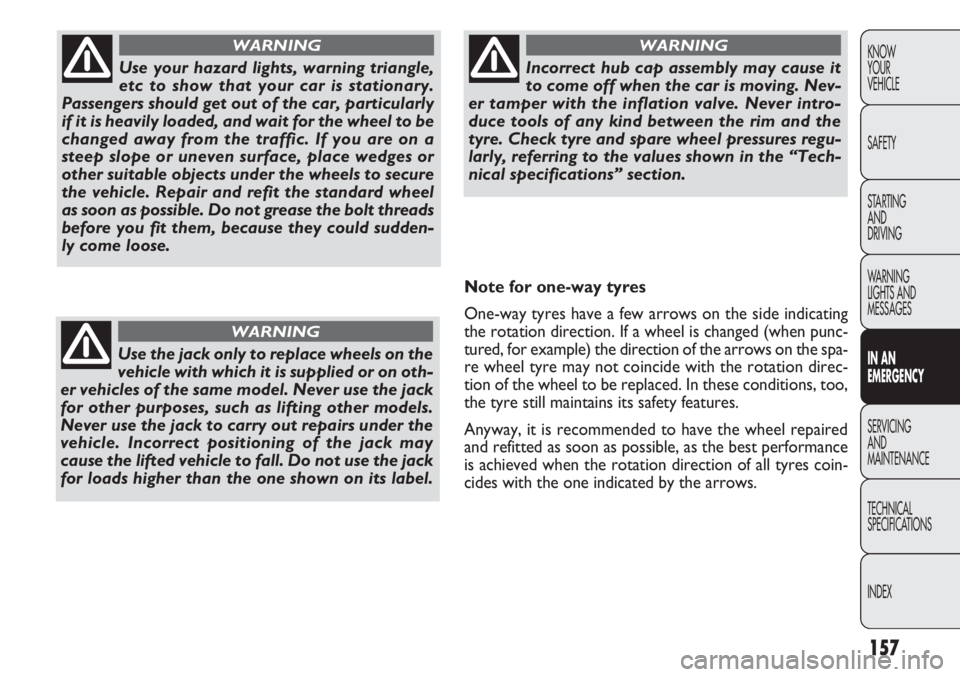
157
KNOW
YOUR
VEHICLE
SAFETY
STARTING
AND
DRIVING
WARNING
LIGHTS AND
MESSAGES
IN AN
EMERGENCY
SERVICING
AND
MAINTENANCE
TECHNICAL
SPECIFICATIONS
INDEXUse your hazard lights, warning triangle,
etc to show that your car is stationary.
Passengers should get out of the car, particularly
if it is heavily loaded, and wait for the wheel to be
changed away from the traffic. If you are on a
steep slope or uneven surface, place wedges or
other suitable objects under the wheels to secure
the vehicle. Repair and refit the standard wheel
as soon as possible. Do not grease the bolt threads
before you fit them, because they could sudden-
ly come loose.
WARNING
Use the jack only to replace wheels on the
vehicle with which it is supplied or on oth-
er vehicles of the same model. Never use the jack
for other purposes, such as lifting other models.
Never use the jack to carry out repairs under the
vehicle. Incorrect positioning of the jack may
cause the lifted vehicle to fall. Do not use the jack
for loads higher than the one shown on its label.
WARNING
Incorrect hub cap assembly may cause it
to come off when the car is moving. Nev-
er tamper with the inflation valve. Never intro-
duce tools of any kind between the rim and the
tyre. Check tyre and spare wheel pressures regu-
larly, referring to the values shown in the “Tech-
nical specifications” section.
WARNING
Note for one-way tyres
One-way tyres have a few arrows on the side indicating
the rotation direction. If a wheel is changed (when punc-
tured, for example) the direction of the arrows on the spa-
re wheel tyre may not coincide with the rotation direc-
tion of the wheel to be replaced. In these conditions, too,
the tyre still maintains its safety features.
Anyway, it is recommended to have the wheel repaired
and refitted as soon as possible, as the best performance
is achieved when the rotation direction of all tyres coin-
cides with the one indicated by the arrows.
Page 162 of 283
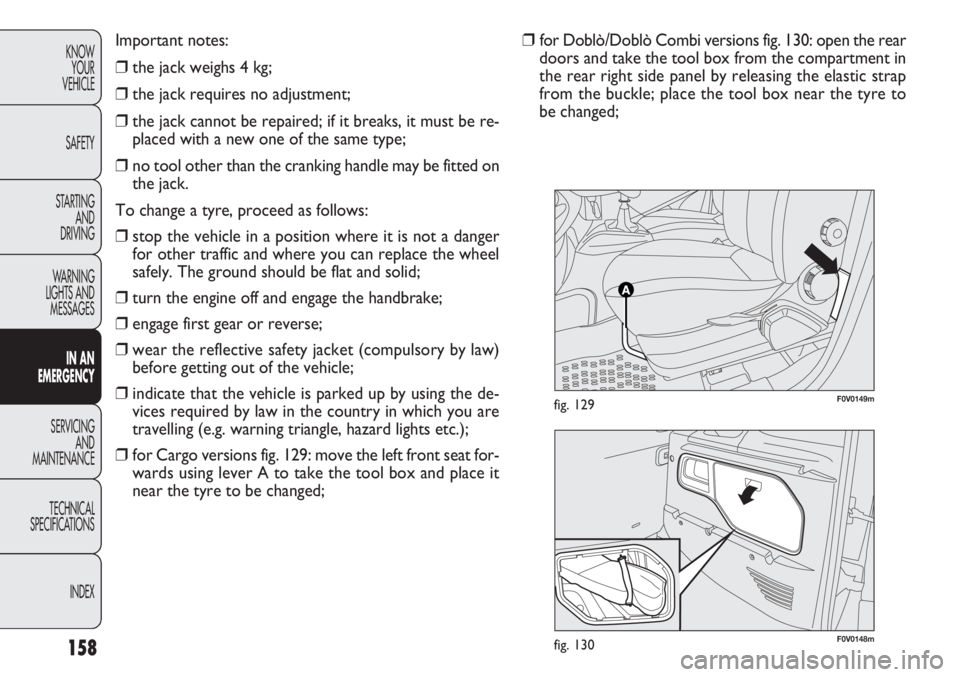
F0V0148mfig. 130
F0V0149mfig. 129
158
KNOWYOUR
VEHICLE
SAFETY
STARTING AND
DRIVING
WARNING
LIGHTS AND MESSAGES
IN AN
EMERGENCY
SERVICING AND
MAINTENANCE
TECHNICAL
SPECIFICA TIONS
INDEXImportant notes:
❒ the jack weighs 4 kg;
❒ the jack requires no adjustment;
❒ the jack cannot be repaired; if it breaks, it must be re-
placed with a new one of the same type;
❒ no tool other than the cranking handle may be fitted on
the jack.
To change a tyre, proceed as follows:
❒ stop the vehicle in a position where it is not a danger
for other traffic and where you can replace the wheel
safely. The ground should be flat and solid;
❒ turn the engine off and engage the handbrake;
❒ engage first gear or reverse;
❒ wear the reflective safety jacket (compulsory by law)
before getting out of the vehicle;
❒ indicate that the vehicle is parked up by using the de-
vices required by law in the country in which you are
travelling (e.g. warning triangle, hazard lights etc.);
❒ for Cargo versions fig. 129: move the left front seat for-
wards using lever A to take the tool box and place it
near the tyre to be changed; ❒
for Doblò/Doblò Combi versions fig. 130: open the rear
doors and take the tool box from the compartment in
the rear right side panel by releasing the elastic strap
from the buckle; place the tool box near the tyre to
be changed;
Page 163 of 283
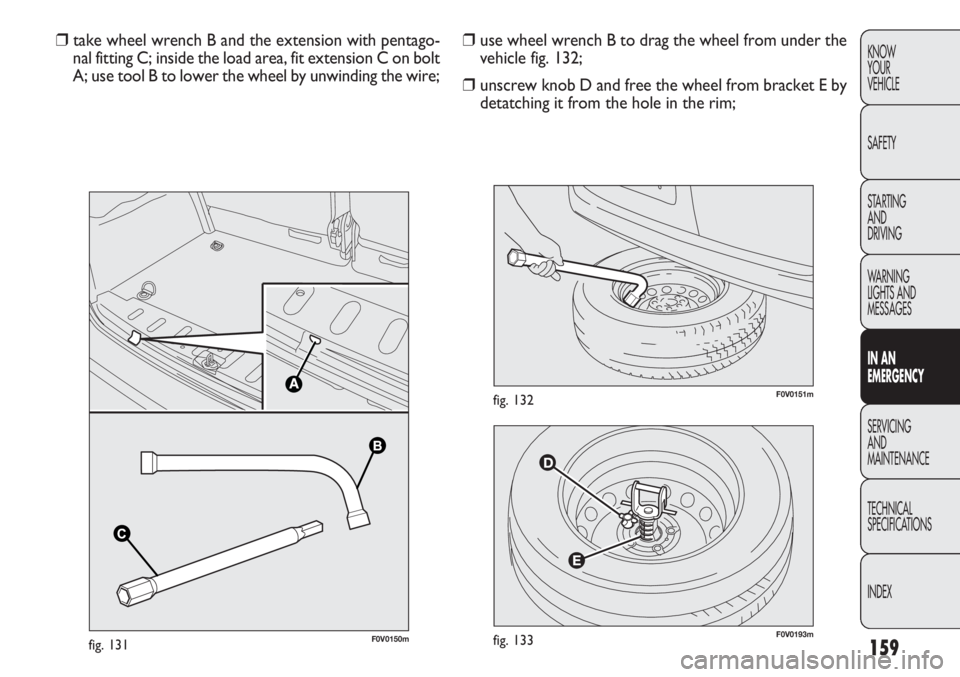
159
KNOW
YOUR
VEHICLE
SAFETY
STARTING
AND
DRIVING
WARNING
LIGHTS AND
MESSAGES
IN AN
EMERGENCY
SERVICING
AND
MAINTENANCE
TECHNICAL
SPECIFICATIONS
INDEX
F0V0193mfig. 133
F0V0151mfig. 132
❒ use wheel wrench B to drag the wheel from under the
vehicle fig. 132;
❒ unscrew knob D and free the wheel from bracket E by
detatching it from the hole in the rim;
❒
take wheel wrench B and the extension with pentago-
nal fitting C; inside the load area, fit extension C on bolt
A; use tool B to lower the wheel by unwinding the wire;
BB
CC
F0V0150mfig. 131
Page 164 of 283
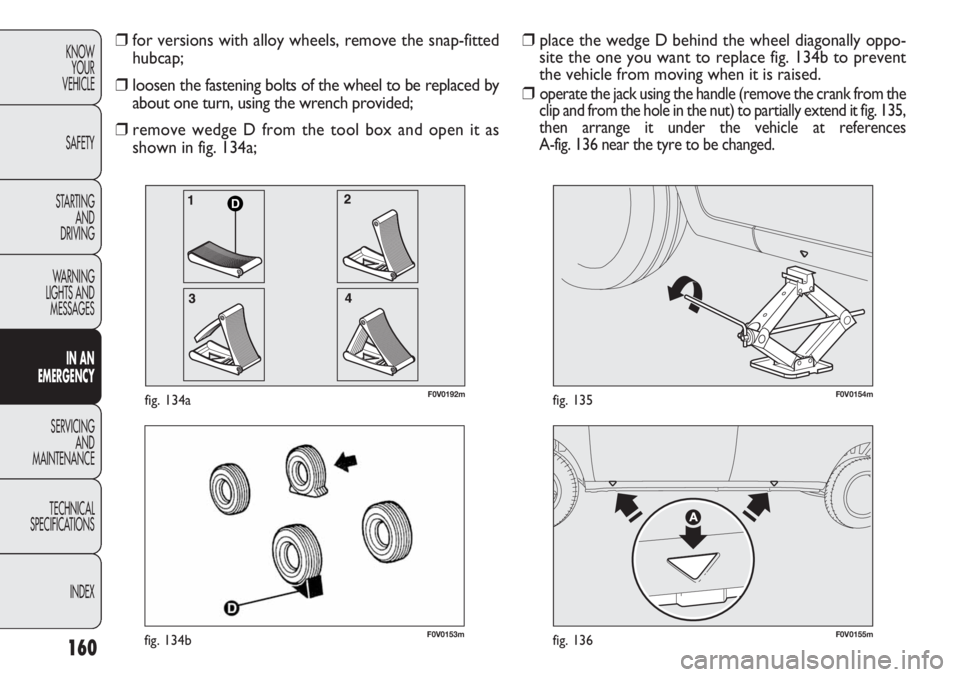
160
KNOWYOUR
VEHICLE
SAFETY
STARTING AND
DRIVING
WARNING
LIGHTS AND MESSAGES
IN AN
EMERGENCY
SERVICING AND
MAINTENANCE
TECHNICAL
SPECIFICA TIONS
INDEX
F0V0153mfig. 134bF0V0155mfig. 136
F0V0154mfig. 135
❒ place the wedge D behind the wheel diagonally oppo-
site the one you want to replace fig. 134b to prevent
the vehicle from moving when it is raised.
❒
operate the jack using the handle (remove the crank from the
clip and from the hole in the nut) to partially extend it fig. 135,
then arrange it under the vehicle at references
A-fig. 136 near the tyre to be changed.
❒ for versions with alloy wheels, remove the snap-fitted
hubcap;
❒ loosen the fastening bolts of the wheel to be replaced by
about one turn, using the wrench provided;
❒ remove wedge D from the tool box and open it as
shown in fig. 134a;
D
F0V0192mfig. 134a
Page 165 of 283
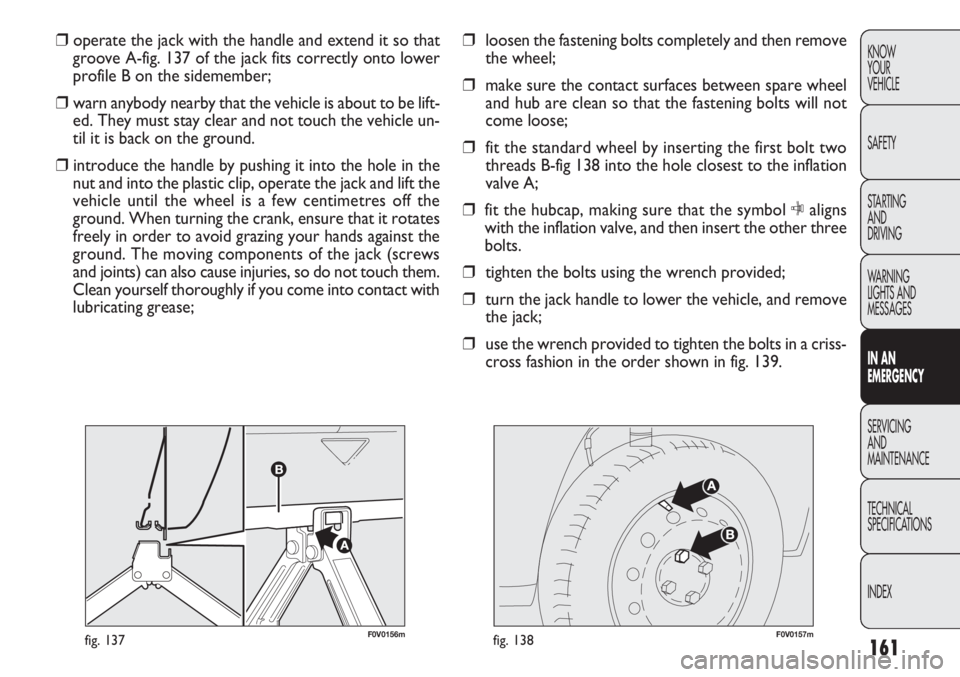
161
KNOW
YOUR
VEHICLE
SAFETY
STARTING
AND
DRIVING
WARNING
LIGHTS AND
MESSAGES
IN AN
EMERGENCY
SERVICING
AND
MAINTENANCE
TECHNICAL
SPECIFICATIONS
INDEX
F0V0156mfig. 137F0V0157mfig. 138
❒ loosen the fastening bolts completely and then remove
the wheel;
❒ make sure the contact surfaces between spare wheel
and hub are clean so that the fastening bolts will not
come loose;
❒ fit the standard wheel by inserting the first bolt two
threads B-fig 138 into the hole closest to the inflation
valve A;
❒ fit the hubcap, making sure that the symbol Caligns
with the inflation valve, and then insert the other three
bolts.
❒ tighten the bolts using the wrench provided;
❒ turn the jack handle to lower the vehicle, and remove
the jack;
❒ use the wrench provided to tighten the bolts in a criss-
cross fashion in the order shown in fig. 139.
❒
operate the jack with the handle and extend it so that
groove A-fig. 137 of the jack fits correctly onto lower
profile B on the sidemember;
❒ warn anybody nearby that the vehicle is about to be lift-
ed. They must stay clear and not touch the vehicle un-
til it is back on the ground.
❒ introduce the handle by pushing it into the hole in the
nut and into the plastic clip, operate the jack and lift the
vehicle until the wheel is a few centimetres off the
ground. When turning the crank, ensure that it rotates
freely in order to avoid grazing your hands against the
ground. The moving components of the jack (screws
and joints) can also cause injuries, so do not touch them.
Clean yourself thoroughly if you come into contact with
lubricating grease;